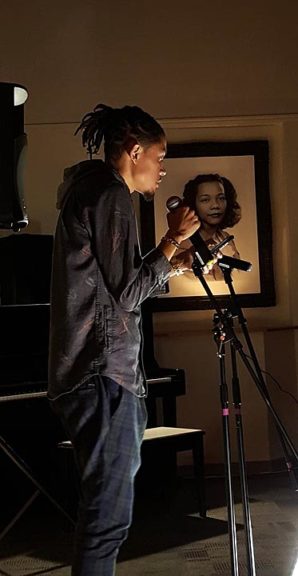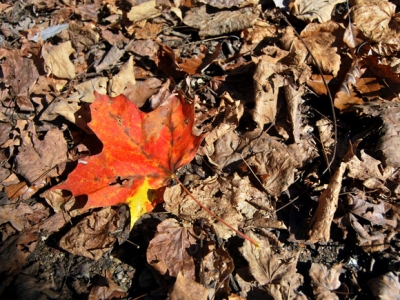Antioch College steps up diversity, inclusion
- Published: January 10, 2019
This article is the fourth in a series on the persistence of racism in Yellow Springs.
At about 100 students, Antioch is a very small college. Due to its small size, students have nowhere to hide when they have conflicts or misunderstandings with each other.
“I’ll say goodbye to someone and five minutes later I’ll see them again,” said 2018 Antioch graduate Marcell Vanarsdale recently. “There’s no anonymity.”

Toledo-based poet JT Robinson performed original poetry and spoken word at the Coretta Scott King Center RHYME & REASON event in October, hosted by the Antioch Creative Collective. (Submitted photo)
Antioch is also a college with a student body that is, for a Midwestern liberal arts school, unusually diverse. The most recent entering class of 48 students is among its most diverse classes since the college re-opened in 2011, according to Associate Director of Admissions Shane Creepingbear in a recent interview, although comparisons are difficult because the college only recently began tracking students’ self-identification regarding sexuality and gender. In this fall’s entering class, about 30 percent of entering students identify as students of color, and almost 20 percent as LGBTQ, an acronym for lesbian, gay, bisexual, transgender or queer.
Those diversity numbers are high compared to other liberal arts colleges in the Midwest, which tend to average around 3 to 10 percent students of color, Creepingbear said.
The reality of a relatively robust percentage of students from diverse backgrounds living together on a small campus can make for a uniquely challenging college experience, according to Antioch leaders. And those leaders, including faculty, staff and students, are aiming to help students address those challenges.
“You can’t run away from these fundamental issues at Antioch,” Antioch College President Tom Manley said recently. “It’s both a challenge and an opportunity.”
This fall, Antioch leaders intensified efforts aimed at helping students of diverse backgrounds develop the skills to live together with respect and understanding. The initiatives go beyond the college’s longtime aim of bringing to campus students of different races, ethnicities, religions, sexual orientation and gender identification. In addition to simply housing a diverse student body, the new initiatives seek to create a campus atmosphere of inclusion in which students of all backgrounds can thrive.
“What we’re trying to do here is more than the traditional approach to diversity,” Associate Professor of History Kevin McGruder said recently. “Without a social justice focus, you just have people on a campus.”
Respect for diversity and inclusion is especially critical at Antioch, given its legacy of support for social justice issues, according to Director of Admissions and External Relations Gariot Louima. That legacy is often summed up in the Horace Mann quote, “Be ashamed to die until you have won some victory for humanity.”
“We talk about helping students lay the foundation for addressing the most important issues of the day,” Louima said recently. “I don’t think we could deliver on our educational promise without having a diverse group of students. This campus should be a laboratory for having these conversations.”
While efforts to enhance social justice and inclusion on campus have recently been stepped up, there are signs that the college is heading in the right direction.
“It takes time, it takes trust, it takes honesty. It’s not an easy process,” said recent graduate Vanarsdale, who is African American and works on diversity issues at the Coretta Scott King Center. “But we’re on our way. It will be exciting to come to Antioch College in a couple of years.”
A complex challenge
In the history of the college, while leaders have consistently articulated the priority of having a diverse student body, efforts at helping those students live together successfully lagged behind, according to Louise Smith, longtime faculty member and current associate professor of performance.
“We seem to be good at diversity, but not so much meaningful inclusion,” she said recently. “We’d bring students of color to campus and just expect things to go well.”
But things didn’t always go well. According to a recent email from McGruder, efforts to improve the level of tolerance and acceptance on campus began in 2011 when leaders received a list of concerns from students of color in the college’s first class after re-opening. An ad hoc committee on diversity was formed to respond to the issues.
In 2013, that group urged then-President Mark Roosevelt to hire a full-time director of the Coretta Scott King Center, a position that was then vacant. Roosevelt and the board agreed, and a search began. Near this time, representatives from the Higher Learning Commission, who were evaluating the college for re-accreditation, noted to college leaders that while diversity was spotlighted as a college priority, there seemed no one person responsible for implementing diversity efforts.
In 2014, Mila Cooper was hired as executive director of the Coretta Scott King Center, a position focused on diversity efforts.
The following year, Cooper and then-Dean of Students Luis Rosa advocated to Roosevelt that a Presidential Task Force on Diversity be created to manage a process for creating a strategic plan for diversity, according to McGruder. This recommendation came in response to several hostile incidents aimed at students of color. According to Cooper and Rosa, an institutional structure was needed to prevent such incidents. Roosevelt agreed, and a group of about 20 faculty, staff and students began meeting, with Cooper and McGruder serving as co-chairs of the group.
That group met over the next 18 months, initially sponsoring a campuswide effort to develop a definition of diversity, and then developing a strategic plan, McGruder said. The college also hired consultants to conduct a diversity audit.
But progress was halting. On his first day on the job in March 2016, new President Manley found on his desk a list of demands from students of color following several recent hostile campus incidents. In response, the college board of trustees held a two-hour open meeting to hear and respond to the concerns of students of color. At about this time, the task force recommended to Manley that an assistant director of diversity be hired immediately, and a senior level position be created in the following year. The assistant director position was created and filled, although that person has since left the position, and in response to the senior-level position request, Cooper’s responsibilities were expanded when she was made vice president for diversity and inclusion.
In June of 2016, the task force presented its strategic plan for diversity and inclusion to the Antioch College board, and the board approved the plan. At that point, the work of the task force was done, although a working group, also led by McGruder and Cooper, remains in place to keep the efforts moving forward.
New in the approved strategic plan was an emphasis not only on diversity efforts, but on inclusion as well.
“By the end of the strategic planning process, our language had shifted from only speaking about diversity, which could be seen as limited to optics, to inclusion, which we interpreted to mean acceptance and participation in the breadth of campus life,” McGruder wrote.
In the spring of 2017, college faculty were asked to redesign the curriculum in order to provide students more flexibility, in response to declining enrollment, an increase in faculty departures and in light of the strain of offering classes to satisfy the college’s 11 majors. After a year’s intense effort, the redesigned curriculum, launched in the fall of 2018, included a series of required classes on diversity and inclusion.
Progress has been made, and enthusiasm for the redesigned curriculum is high, McGruder said.
But significant challenges remain. While the college has attained a robust level of diversity in its newest class, diversity among faculty lags behind. About five faculty members identify as people of color, according to McGruder, although he is the only African-American faculty member in a faculty of about 25.
Even more significantly, student retention remains a challenge. The percent of students who leave the college each year is high, more so than at comparable schools. And while retention is a problem for all students, it’s especially a problem for students of color and LGBTQ students, McGruder said.
At times, the revived college’s effort toward creating a campus atmosphere of tolerance and acceptance is constrained by the reality of limited resources, he said. For example, while mental illness is identified as a growing problem on college campuses nationwide, at Antioch there is only one mental health counselor for 100 students.
Most significantly, young people who come to Antioch, like young people everywhere, sometimes need guidance in encountering those who are different than they are.
While Antioch has been on the progressive edge of social justice efforts since its 1853 beginning, those efforts have mainly focused on the world off campus, according to Cooper, with an emphasis on how Antioch students could influence that external world, rather than how students relate to each other.
“Kevin [McGruder] and I believe that social justice is not just external,” Cooper said. “We think this is a training ground for how to be involved in social justice issues when you leave here and go out into the world,” she said.
According to McGruder, it’s all about creating a world on campus that not only accepts differences between people, but values and honors those differences.
“We don’t just want our students to survive, we want them to thrive,” he said.
Tools for dialogue
A critical piece of the college’s recent redesign of curriculum is three required classes that focus on diversity and inclusion.
“The new curriculum requires that students think in a deep way about these issues,” Admissions Director Louima said.
A centerpiece for the new curriculum is “Dialogue Across Difference,” a new course required for freshmen. The course aims specifically to help students gain tools for dealing with those who are different than they are in terms of race, ethnicity, religion, sexual orientation or gender identification.
Introduced for the first time in fall 2018, the course was taught by Louise Smith, associate professor of performance, and mental health counselor Nzingha Dalila. This winter the course will be taught by McGruder and Co-op Instructor Luisa Bieri, along with Residence Life Coordinator JP Robinson. The course was created by the four faculty members who are teaching it this year.
While many colleges and universities offer a variety of courses that address diversity in a theoretical way, “Dialogue Across Difference” aims to do something more. Along with offering students an intellectual lens through which to examine their own attitudes toward those who are different than they are, the course seeks to teach the practical skills needed to communicate effectively across differences.
“We tried to both give students a framework and create a space for them to practice,” Smith said in a recent interview. “It’s a tall order.”
Each professor will bring a slightly different focus to her or his class based on their own area of expertise. Smith, a licensed mental health counselor as well as a theater professional, brought an emphasis on communication techniques.
In her class, students began with readings and lectures that looked at the structural and systemic forces of racism. She also introduced students to mindfulness techniques, to enhance their awareness of their own thinking process. In the practical component of the class, students were introduced to various strategies to enhance listening, including active listening. And near the end of the class, students looked at their own assumptions and conflicts.
“Toward the end of the class we got to places of discomfort,” she said. “This is a growth edge for all of us, especially for white students.”
Class content was clearly difficult for some students, so at the end of the quarter Smith was surprised at the largely positive feedback from students. The class evaluations “ran the gamut from ‘I didn’t learn much in this class’ to ‘This class changed how I relate to people.’” Smith said. “I observed some students find their voice in this class.”
The class will take a slightly different focus this winter, when it’s taught by historian McGruder, who will offer a historical lens on racism, and Bieri, who will include techniques from the Theater of the Oppressed, which uses theater as a strategy for social change. Bieri will teach the class with Residence Life Coordinator JP Robinson.
“We’re creating this from the ground up,” Bieri said recently. “It’s a unique approach, combining a basic understanding of race/class/religion/ethnicity and sexuality with a practical side.”
What’s unique about “Dialogue Across Difference” is the teaching of practical skills with which to take the theoretical understanding of diversity out into the world, according to President Manley. This focus on face-to-face skills is part of a new collegewide emphasis on the practical applications of its educational offerings. Those applications are highlighted in the college’s five new “areas of practice” that anchor the new curriculum, including the area of “Deliberative Democracy, Diversity and Social Justice.”
“Unless we’re creating the know-how and the habit of mind, you’re not living those values,” Manley said.
After first taking “Dialogue Across Difference” soon after they arrive on campus, Antioch students are now also required to take two upper-level theoretical classes, one focused on critical race studies, and another on gender and sexuality.
Along with required classes on diversity, the college supports students’ interests in social justice through their co-op jobs as well, according to Bieri, of the co-op department. For instance, students have in recent years been placed in nonprofits such as Black Alliance for Just Immigration and 67 Suenos, an American Friends Service Committee organization working with young migrants excluded from the federal Dream Act.
“We’re trying to support students who have an interest in engaging in a passion around social justice,” Bieri said.
The college also provides on-campus support for social justice endeavors, such as a student-run campaign to provide donated books to prisoners at the Dayton Correctional Institute, or DCI. And the college supports the Antioch Creative Collective, or ACC, a student-led group cofounded by Vanarsdale that last fall sponsored several spoken-word events to reach out to students of color, including 24 African-American students from Wilberforce University who, through a collaborative effort with the college, were housed in an Antioch dorm last fall. While that housing collaboration is now over, Manley said recently he welcomes other opportunities to collaborate with Wilberforce.
On campus, students also have the opportunity to join student-led interest groups, some of which are structured around identity, such as an interest group for students of color.
“It’s a place where students can let down their hair, can enjoy the cultural difference,” Cooper said of the interest groups.
The recent ACC-led events and other collaborative efforts were encouraging to Vanarsdale, who comes from an urban black neighborhood in Chicago.
“Culturally, I feel more comfortable,” he said of being on the Antioch campus in the past year compared to when he first arrived on campus. He also emphasized that students of color on campus come from varied backgrounds, so he was speaking for himself only.
Still, while Antioch College seems to be making progress on diversity and inclusion, the goal is always somewhere on the horizon.
“We are more conscious and conscientious about diversity and inclusion and how to practice it than some schools, but we are not paragons, not holding ourselves up as a model,” Manley said.
And to Louima, who is Haitian and whose job is to bring more students of diverse backgrounds to campus each year, the end point remains elusive.
“In some ways the work is always ongoing,” he said. “There’s not a measurable endpoint that shows full inclusion. We always have to question our assumptions and our practices, with the understanding that we will never be fully there.”
The Yellow Springs News encourages respectful discussion of this article.
You must login to post a comment.
Don't have a login? Register for a free YSNews.com account.

Parkinsons.jpg)













No comments yet for this article.